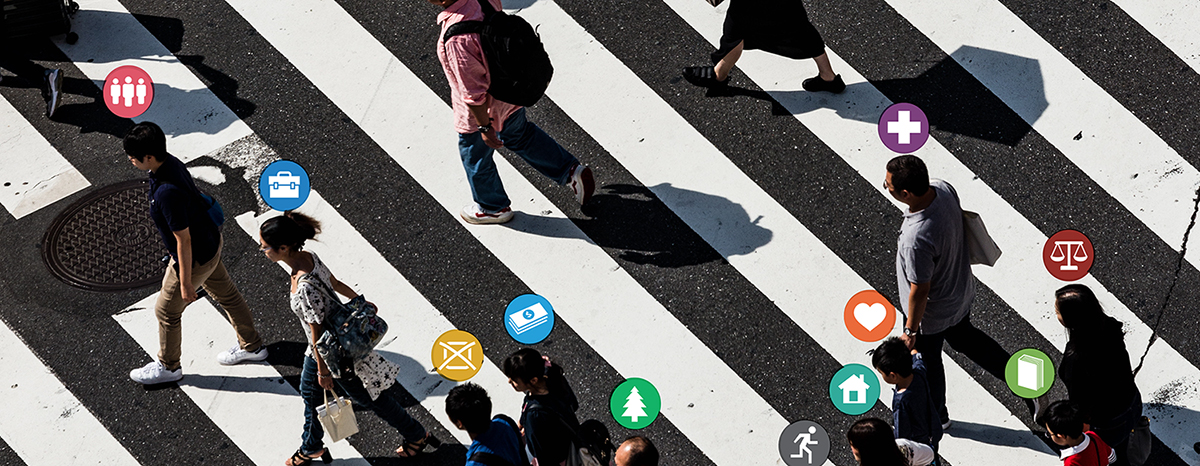
Cities as Beacons for Wellbeing
mars 19, 2018 — The Big Picture
When imagining the streets, parks, canals, or squares of any city our minds automatically picture human faces. Some are playing in the grass, others walking to work, taking a bus to school or catching up with friends and family. These snapshots reflect the reality that a city is more than just its physical infrastructure. Indeed, Romans used the term “civitas”, referring to an ever-evolving and vibrant social fabric made up of the lives of the people within it.
From Norilsk near the Arctic Circle to Ushuaia at the tip of Argentina, the experiences of citizens on their urban journeys will influence their quality of life and ultimately their state of happiness.
For a city to prosper, its inhabitants must be able to identify with and feel part of its values and aspirations. As the Pritzker Prize-winner Alejandro Aravena said during the 2016 OECD Forum: “cities need to be magnets of opportunities”. We might even take this statement further to add “and beacons of wellbeing”.
One of the first steps we can take to pave the way is to change how we look at economic growth and the wellbeing of societies, going beyond traditional macroeconomic measurements to grasp a fuller picture of the reality of people’s daily lives. As the saying goes: measure what you treasure.
After the economic and financial crisis in 2008, it became strikingly apparent that growth for growth’s sake was not enough, and that the OECD had a role to play in sparking new thinking and approaches. In 2011, we launched the OECD Better Life Initiative, and with it, an instrument for engaging the public around wellbeing, the Better Life Index. The initiative focuses on the measurement and analysis of quality of life in countries, regions and cities – an effort to capture the many aspects that matter to people and shape their lives. These range from having access to basic health services, education, clean air and water, a political voice to feeling safe walking alone at night. The Index helps individuals understand how their living conditions relate to the reality in their countries and around the world.
It also provides you with a space to voice your opinion on what makes a “good life” through the creation of your own Index. We look at the responses, where they are coming from and what rises to the top in terms of people’s preferences. To date, we have had over 11 million visits to the platform with particularly high engagement from our communities in Mexico City, London, Paris, Sydney and New York. So, what have we learned from listening? People coming to the Index from Mexico rank education highest, while those in France say health comes first, and in Australia, work-life balance. In the United States and the United Kingdom, it’s life satisfaction that comes out on top.
As cities realize their potential as agents for positive change, their challenge will not only be to improve the quality of their inhabitants’ lives, but also to involve them in that process. We’ve witnessed this thinking in various initiatives emerging from cities that have collaborated with us, using our platform. We tapped into the energy of the 2014 World Cup in São Paulo, together with football legend Pelé to introduce the Index in Portuguese and ask people: “Is there #more2life than football?” In Milan, we embraced the 2015 Expo’s gastronomic focus and asked visitors what was their ideal recipe for an appetizing life. We met with locals at ThinkBDPST and heard their stories about the importance of quality jobs, entrepreneurship and innovation for catalysing societal progress in Budapest. We draw inspiration from the innovative Santa Monica Wellbeing Project, where the local government uses data and community action to ensure residents thrive in areas like early childhood education. Last but not least, in the Canadian landscapes of Gatineau and Rivière-du-Loup, the Better Life Index was adapted to survey residents on how to improve their environment so that they could have healthier lifestyle habits.
These examples are but a few of the many ways that cities can put wellbeing and people at the center of urban policies. Uplifting and sharing stories, providing tools for understanding what wellbeing means personally and collectively, and taking advantage of opportunities for improving lives in these spaces is something we can co-create.